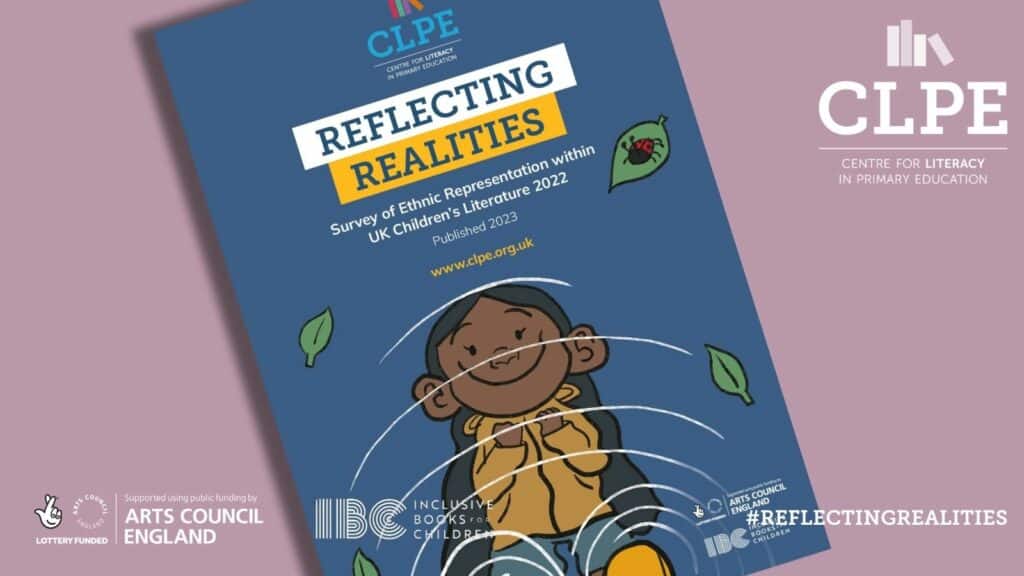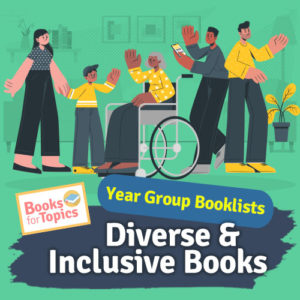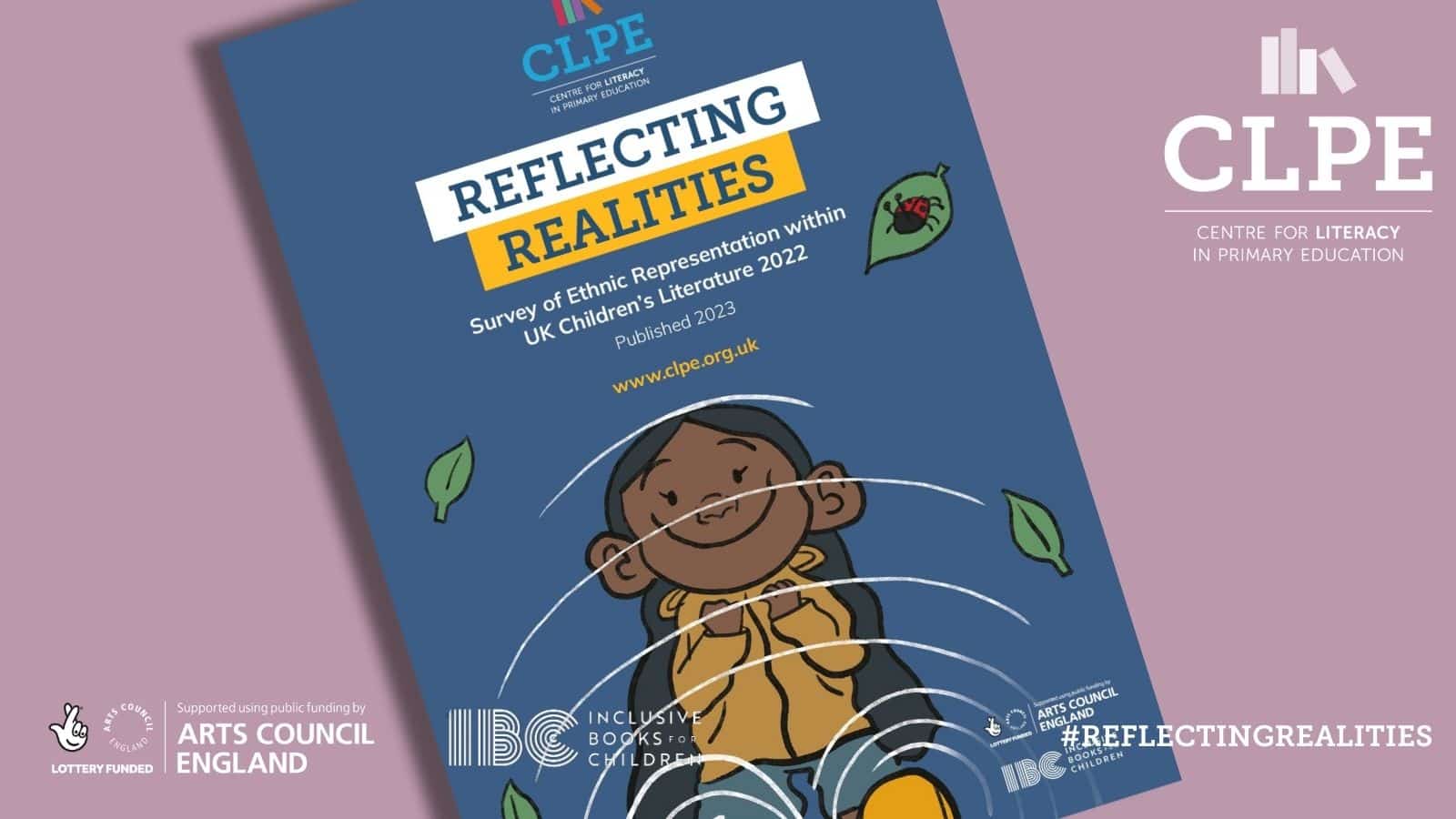
November 30th, 2023
The 6th Annual CLPE Reflecting Realities Report – Just Released
Latest Findings – Sustained Upward Trend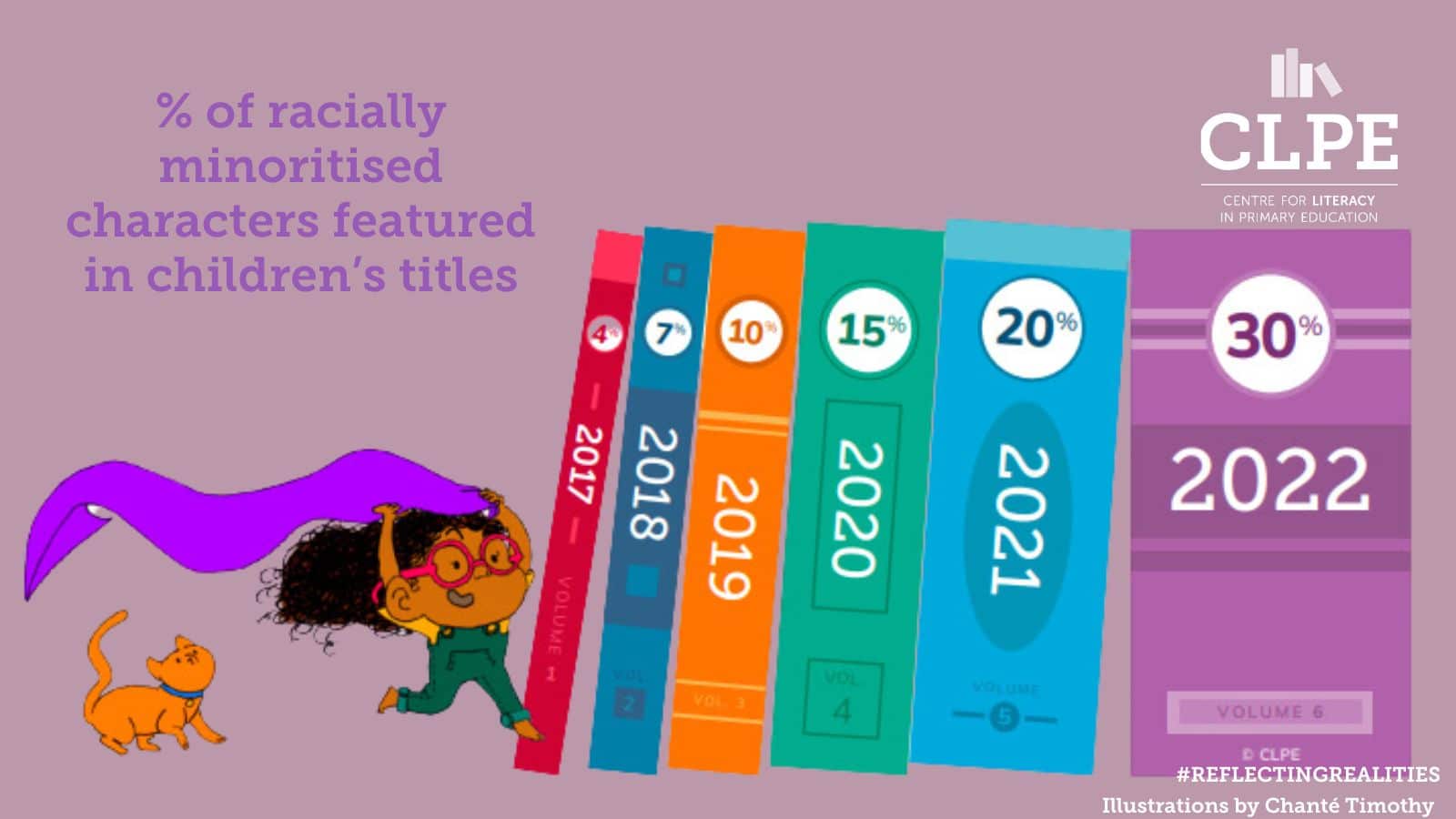
This month, the Centre for Literacy in Primary Education (CLPE) released its 6th annual Reflecting Realities Survey of Ethnic Representation within UK Children’s Literature. The newly published report can be viewed here and you can read more about the methodology behind the report here. Chante Timothy illustrates this year’s report.
The latest summary of findings indicates that 30% of children’s books published in 2022 feature a racially minoritised character, a significant and consistent increase from the 4% first reported in 2017.
This increase is also echoed in the upward trend of racially minoritised main characters up from 1% in 2017 to 14% in 2022 and a 5 percentage point increase on last year.
Variation Across Text Types
For the first year in its history, the report shows a decrease in minority representation in picturebooks and non-fiction for 2022. Only fiction titles showed an increase in racially minoritised presence, while there was a year-on-year decrease in presence for non-fiction and picturebooks.
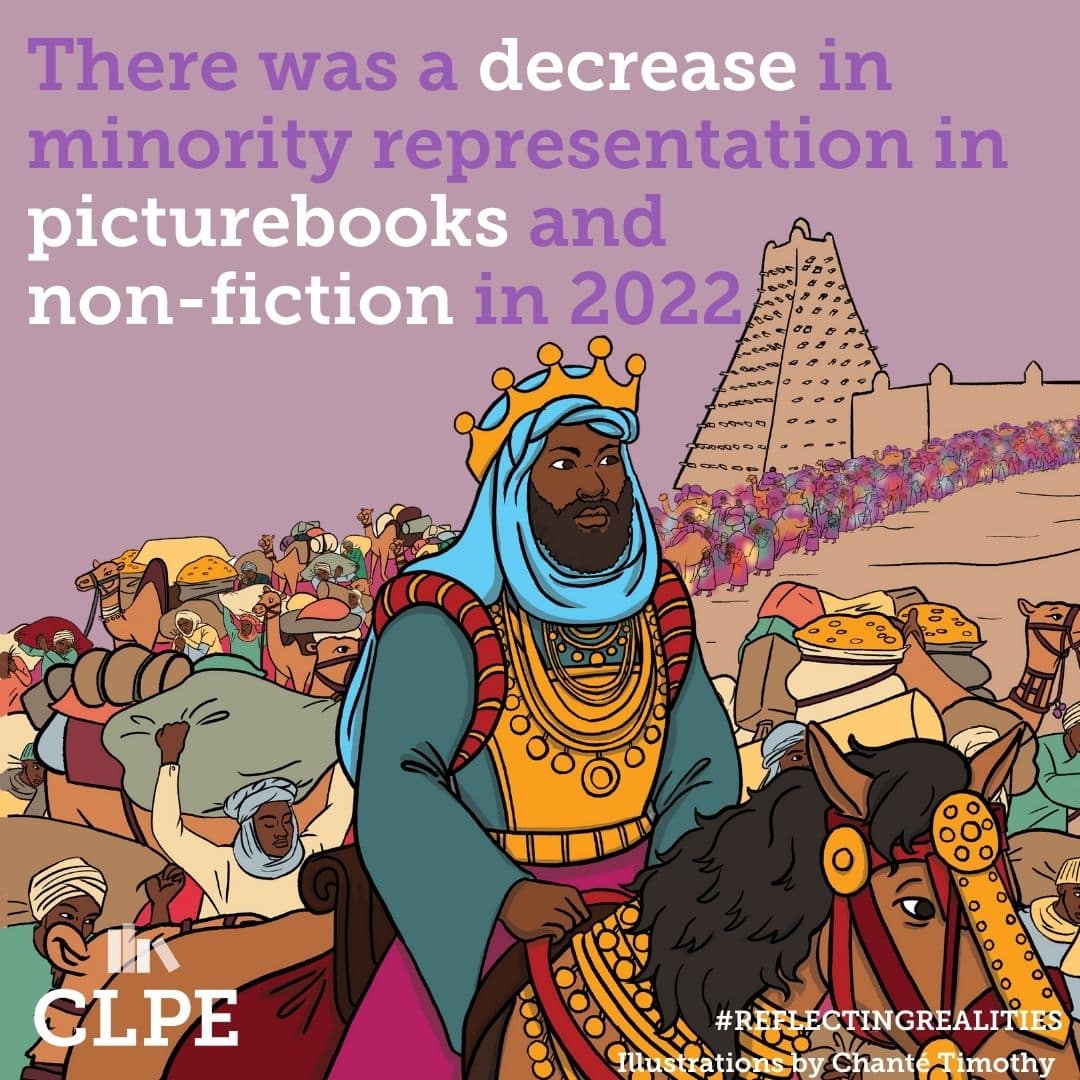 Minoritised representation in fiction increased from 11% in 2021 to 15% in 2022, while representation in non-fiction dropped from 41% in 2021 to 30% in 2022, and picturebooks from 61% to 52% year on year.
Minoritised representation in fiction increased from 11% in 2021 to 15% in 2022, while representation in non-fiction dropped from 41% in 2021 to 30% in 2022, and picturebooks from 61% to 52% year on year.
Nonetheless, the increase in representative fiction was welcomed by CLPE as much needed and going some way towards closing the marked gap between the text types, but warns it will be important to continue to carefully monitor the gap to ensure that the gains made in recent years are not undermined through a regression of presence.
The commendable 26 percentage point rise in representation from the first report indicates that there are significantly more representative titles available to young readers now compared to 6 years ago.
What is Meaningful Representation?
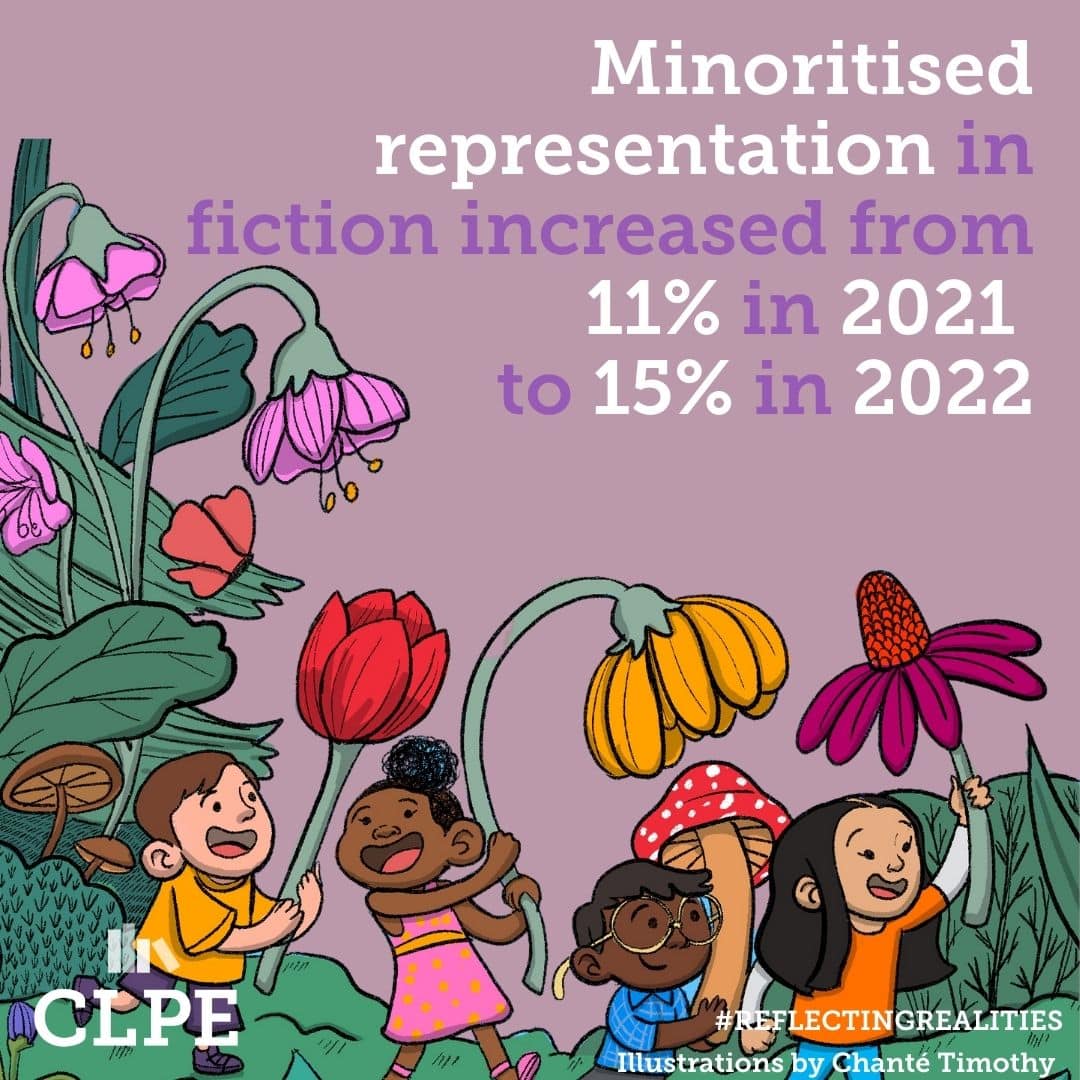 The report also comments on some of the challenges to the research process, including identifying meaningful representations of character. This quality is often easier to analyse in illustrated titles, where the appearance of skin tone, physical characteristics, props and visual cues contribute to the character portrayal.
The report also comments on some of the challenges to the research process, including identifying meaningful representations of character. This quality is often easier to analyse in illustrated titles, where the appearance of skin tone, physical characteristics, props and visual cues contribute to the character portrayal.
However, in non-illustrated fiction, the lack of text-based cues to support the identification of racially minoritised characters was raised as a difficulty. The report writers bring to light the question: Can a book be considered meaningfully representative and inclusive if the portrayal of racially minoritised characters is indecipherable?
With that in mind, the report praises work where character details are thoughtfully and authentically incorporated. The report writers direct readers to the world of creatives who “seemingly effortlessly achieve such standards” – naming several authors including Catherine Johnson, Patrice Lawrence, Varsha Shah and Sabine Adeyinka. The report says of these writers:
“What they all have in common is their ability to draw on their intimate knowledge of the realities, communities and cultures they seek to represent and a real dedication to carefully considered research. They in turn use this knowledge and research to shape well-crafted multi-dimensional characters with subtle details that provide enough insight to develop understanding, invite connection and paint a picture in the reader’s mind.”
Exemplified Texts
This year’s report pays particular attention to the range and breadth of genres that have seen minoritised characters become a meaningful part of the literary mainstream. From Fantasy and Historical to Comedy, the report highlights and celebrates stories that include racially minoritised characters in multi-dimensional and nuanced ways. The report names quite a number of texts that exemplify the “quality of presence they hope to encounter in all representative books.”
A list of the texts named in the report can be viewed here. Titles highlighted include a number that the BooksForTopics community will recognise from our Diverse Children’s Book Lists as well as our Year Group Recommended Reads and Curriculum Booklists, such as The Lizzie and Belle Mysteries: Drama and Danger, India Incredible India, Serena Patel’s Picture Perfect, Planet Omar and Joseph Coelho’s Our Tower.
Checklist of Key Questions
Recognising the importance of teachers, booksellers, librarians, book champions and organisations that are doing excellent work on the ground on a day-to-day basis, the report writers reiterate the checklist of key questions from last year’s reports, particularly useful for those involved in children’s publishing, curation and book selection:
Determining Meaningful Presence
Do the characters of colour featured in the books we publish/stock reflect the UK population and the world at large, not as a tick box exercise but as a meaningful and accurate representation of the interconnected, diverse society within which our children are growing up?
Are characters of colour central to a broad range of narratives?
Do characters of colour exist across a range of genres and within both fiction and non-fiction?
Are there a variation and balance of themes explored in the titles in which characters of colour feature?
Have you been attentive to the position that a character of colour holds in the narrative? What position does the character hold? What is the dynamic within the cast? What is the extent of their agency and contribution to the plot?
Have careful research and consideration been exercised to ensure respectful, nuanced and layered portrayals of characters of colour?
Are characters of colour well developed and authentically portrayed? How effectively are their being and personality conveyed?
Ensuring Breadth and Balance
Are readers able to encounter varied portrayals of characters of colour, depicted with a range of personalities and represented as experiencing a full spectrum of emotions in the books you produce/ stock?
Is the content of our titles balanced, allowing for cultural specificity without reducing characterisations to derogatory stereotypes or one-dimensional shorthand?
Have we assessed the balance of our output/ stock to ensure that characters of colour are not predominantly defined by their struggle, suffering, exceptionalism or ‘otherness?
Valuing the Creatives
Is there a sustained investment in both established and new authors from a range of backgrounds who are able to paint characters and worlds with the integrity that the subject matter deserves? Does your output/ stock reflect this diversity of talent?
Looking Ahead
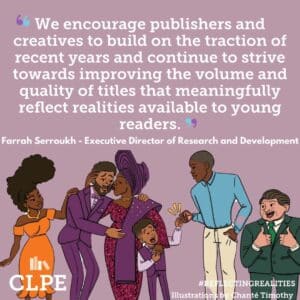 There is still some way to go before UK children’s books more accurately reflect the reality of the school population of England, but the speed of change serves to reinforce the benefit and tangible impact of the survey and a wide range of other initiatives across the publishing, charity and literature sectors. It is the intention of CLPE and their partners to continue to publish this survey, at least for the next few years.
There is still some way to go before UK children’s books more accurately reflect the reality of the school population of England, but the speed of change serves to reinforce the benefit and tangible impact of the survey and a wide range of other initiatives across the publishing, charity and literature sectors. It is the intention of CLPE and their partners to continue to publish this survey, at least for the next few years.
Farrah Serroukh Executive Director of Research and Development said: ‘We welcome the increase in overall output and were pleased to encounter more variation in the breadth of realities reflected in the literature we reviewed. We encourage publishers and creatives to build on the traction of recent years and continue to strive towards improving the volume and quality of titles that meaningfully reflect realities available to young readers.’
If you want to expand your stock of diverse books for children, why not browse our diversity hub featuring booklists covering the primary age range?
> Browse our Topic Booklists
> Visit the Reflecting Realities Booklist
> Go to our Diversity Booklists
> View our Printable Year Group Booklists.
> See our Books of the Month.








